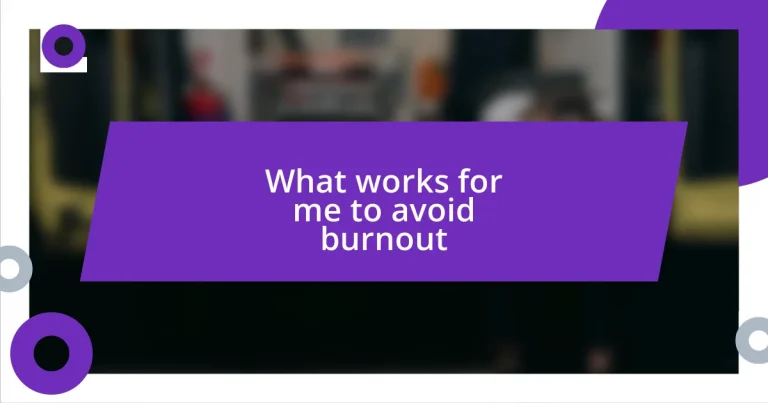Key takeaways:
- Understanding the distinction between fatigue and burnout is crucial for maintaining mental well-being, as recognizing early signs can prevent deeper issues.
- Identifying personal burnout triggers and making small adjustments, such as prioritizing self-care and managing time effectively, helps in avoiding burnout.
- Incorporating regular physical activity, practicing mindfulness, and maintaining a balanced lifestyle through hobbies and healthy eating are essential strategies to combat burnout.

Understanding fatigue and burnout
Fatigue and burnout are often misunderstood, yet they are crucial concepts in maintaining our well-being. Fatigue can creep in gradually; I’ve experienced days when just getting out of bed felt like climbing a mountain. It’s that overwhelming sense of tiredness that makes even simple tasks feel monumental, and when we don’t address it, it often evolves into something much darker—burnout.
Burnout, on the other hand, is more than just physical exhaustion; it seeps into your emotional and mental well-being. I remember a period in my life when I was so consumed by work that I lost interest in activities I once loved, like reading and hiking. Have you ever felt that sense of detachment from things that used to excite you? That’s a red flag that should never be ignored. Understanding the distinction helps us take proactive steps before reaching that tipping point.
Recognizing the signs of both fatigue and burnout is key to preventing deeper issues. For me, it started with chronic irritability and an inability to focus. Have you noticed how easily we dismiss these feelings as just part of life? It’s vital to stop and assess our emotional health; acknowledgement can be the first step towards healing. By learning to identify these feelings early on, we can cultivate a healthier balance in our lives.
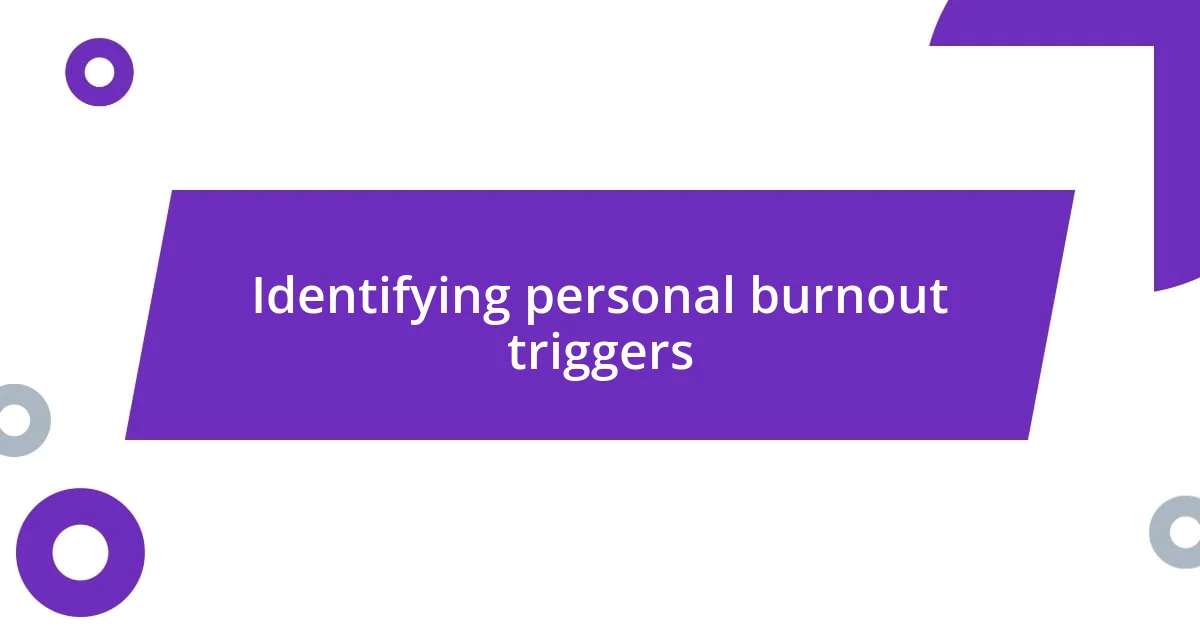
Identifying personal burnout triggers
I’ve come to realize that identifying personal burnout triggers is crucial for maintaining my mental and emotional well-being. There are often specific situations or environments that seem to spark those feelings of overwhelming fatigue and disinterest. For me, it’s been those late nights at work combined with neglecting my personal time. It feels as if I’m caught in a loop, and recognizing this pattern has allowed me to take preventive measures.
Here’s a list of common triggers that might resonate with you:
– Long work hours without breaks: I find that pushing through the day without stepping away can be draining.
– Lack of social interaction: Isolation can amplify feelings of burnout; reaching out to friends, even if it’s just a text, helps balance my mood.
– Unrealistic expectations: Setting goals that are too ambitious can lead to disappointment, which I’ve learned is counterproductive.
– Neglecting self-care: Skipping my routine exercises or not making time for hobbies has a direct impact on my mental state.
– Conflict in personal relationships: Tensions at home or in the workplace can weigh heavily; I notice my mood shifts dramatically in these situations.
By paying attention to these triggers, I can make small adjustments to avoid the slippery slope into burnout. It’s about being tuned in to my needs and feelings, which is a practice worth cultivating.
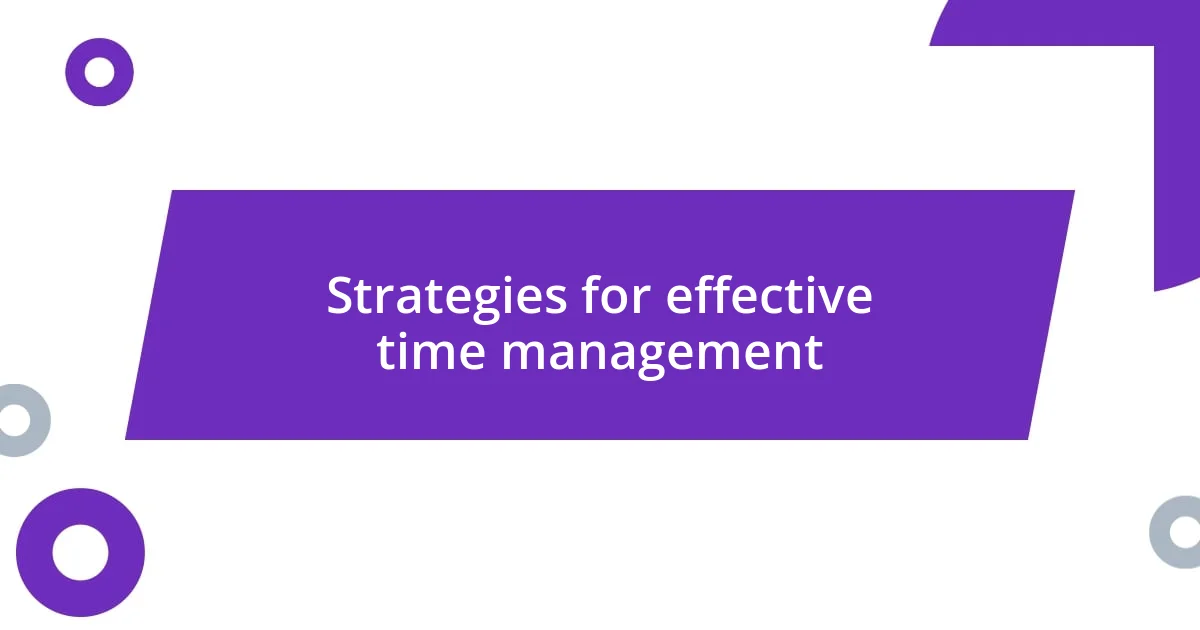
Strategies for effective time management
Time management is a game-changer in preventing burnout. I remember when I first started using a planner; it felt like finding a light switch in a dark room. By allocating specific time slots for tasks, I reduced that overwhelming sense of chaos that often led me to feel burnt out. Have you ever tried just listing out your day? It’s incredible how something so simple can make a substantial difference in your mindset.
Another strategy that has worked wonders for me involves prioritizing tasks. At the beginning of each week, I take a moment to identify what truly needs to get done. I often create a list categorized into “urgent,” “important,” and “nice to do.” This method not only clears my mind but gives me a sense of accomplishment as I tackle each task. Have you ever felt the satisfaction of crossing off completed items? It shifts my focus away from what’s left to do and onto what I’ve already achieved.
Finally, I can’t stress enough the importance of blocking out time for breaks. I like to treat them like mini-rewards. For instance, after an hour of focused work, I’ll stand up, stretch, or even grab a quick snack. It brings me back to the present and refreshes my mind. If I neglect these little pauses, I can feel my energy dwindle faster—do you feel the same? Keeping this rhythm in my day has helped me stay energized and prevents that afternoon slump that often leads to burnout.
| Strategy | Description |
|---|---|
| Using a Planner | Allocate specific time slots for tasks to reduce chaos. |
| Prioritizing Tasks | Identify tasks by urgency and importance to boost focus. |
| Taking Breaks | Incorporate short breaks to maintain energy and clarity. |
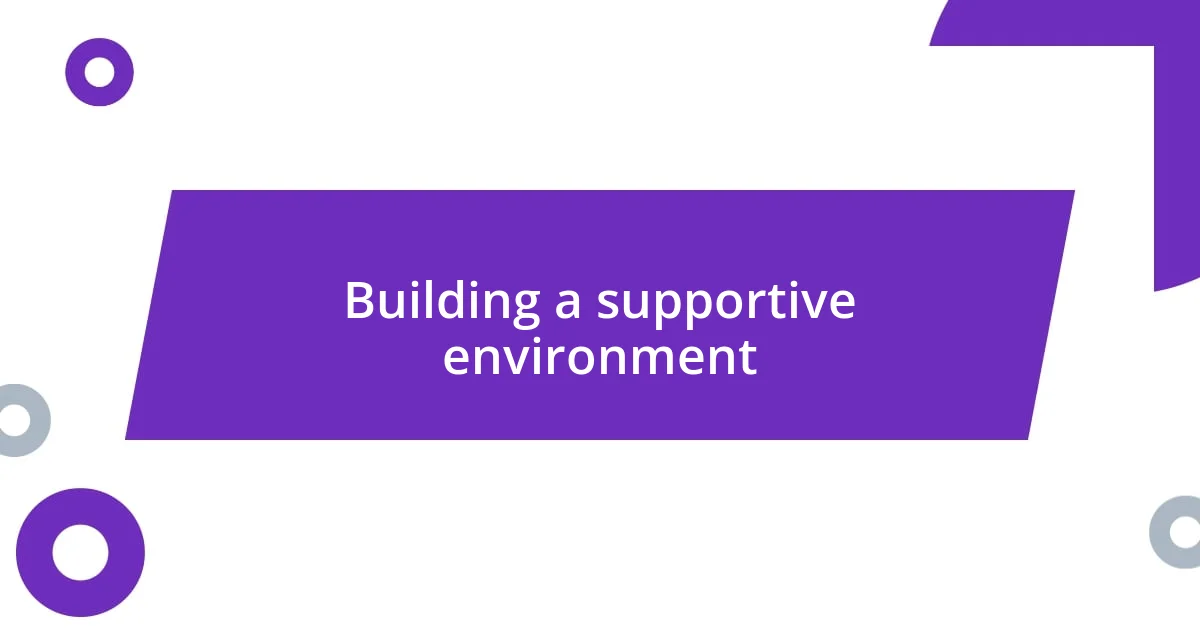
Building a supportive environment
A supportive environment can truly make or break our ability to maintain balance. I distinctly remember a time when a simple gesture from a coworker—a warm cup of coffee delivered right when I was feeling overwhelmed—shifted my entire day. Have you ever experienced that? It highlighted for me the profound impact of small acts of kindness and how they contribute to a culture where everyone feels valued and understood.
Creating this support extends beyond just individual gestures; it’s about fostering a community. For instance, when my team began sharing our challenges openly during meetings, we started to build a group dynamic that felt both reassuring and empowering. It made me realize how crucial vulnerability is; knowing that others are navigating similar struggles helps normalize the experience. Don’t you think that sense of shared experience could lighten the load for many of us?
Additionally, I’ve seen how physical spaces can enhance or hinder support. In my workplace, we introduced cozy meeting areas that facilitate casual conversations. It’s in these moments, sipping tea and engaging in light chatter, that I often find my stress melting away. Picture how you might feel if there were spaces urging you to pause, reflect, and connect. It’s those little changes that remind me I’m not alone—an essential ingredient in avoiding burnout.
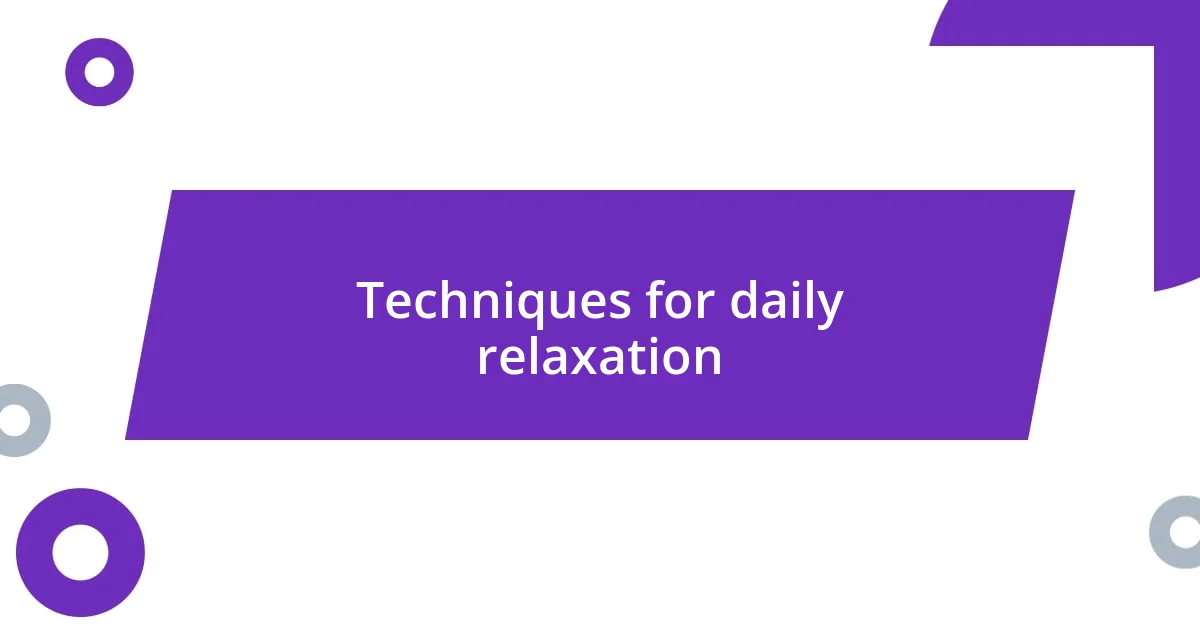
Techniques for daily relaxation
Engaging in daily relaxation techniques has been a vital part of my routine, especially when it feels like life is moving too fast. One method that I’ve come to adore is practicing mindfulness meditation. Just a few minutes of focused breathing can ground me, reconnecting me to the present moment. Have you ever noticed how, in just five minutes of stillness, the chaos around you feels more manageable? It’s like hitting the refresh button on your brain.
Another approach that brings me joy is incorporating gentle movement into my day. I often take a short walk outside, even if it’s just around the block. The fresh air feels invigorating, and I find that nature’s beauty never fails to lift my spirits. It’s fascinating how a change of scenery, even for a few minutes, can spark creativity and promote clarity. Do you ever feel that burst of energy after stepping outside? It’s a small shift, but its impact is profound.
I also cherish my evening ritual of winding down with a good book or a calming cup of herbal tea. These quiet moments allow me to reflect and unwind from the busyness of the day. There’s something deeply soothing about disconnecting from screens and immersing myself in a different world. Have you found a time in your day where you can indulge in a little me-time? This simple act of self-care not only promotes relaxation but also helps cultivate a deeper connection with myself, ultimately keeping burnout at bay.
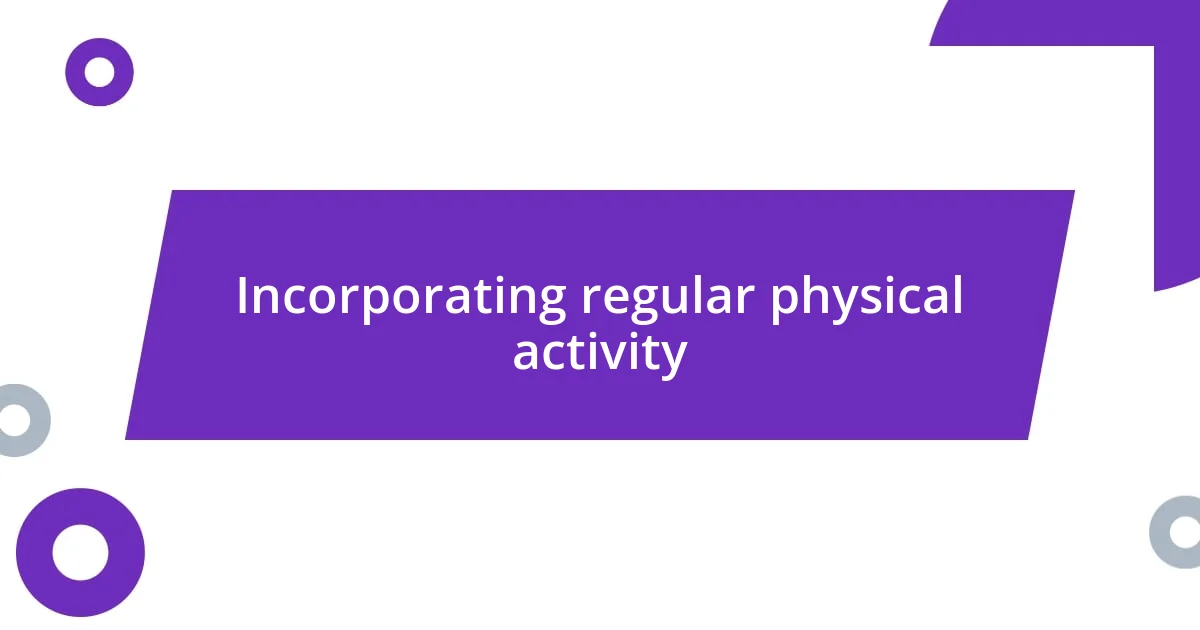
Incorporating regular physical activity
Incorporating regular physical activity into my routine has been a game changer in preventing burnout. I vividly recall a period where relentless deadlines drained my energy, leaving me feeling stuck. It was during one particularly hectic week that I decided to join a local yoga class. The moment I stepped onto the mat, I felt an enormous weight lift off my shoulders—doesn’t it feel liberating to move your body in ways that bring joy?
I’ve discovered that even short bursts of exercise, like a quick run or an impromptu dance session in my living room, can lead to significant mood improvements. After a 20-minute jog around my neighborhood, I notice my worries transform into clarity and enthusiasm. It’s interesting how something as simple as a few minutes of movement can shift our mindset so drastically—have you ever intentionally moved for just a few minutes and felt an instant mood boost?
Moreover, I’ve learned to pair my physical activity with social interaction to elevate the experience. A regular weekend hike with friends not only rejuvenates my body but also nourishes my soul. Sharing laughs and deep conversations in nature reminds me that I’m part of a community. Wouldn’t you agree that blending exercise with connection amplifies the benefits, making it feel less like a chore and more like a cherished time together?
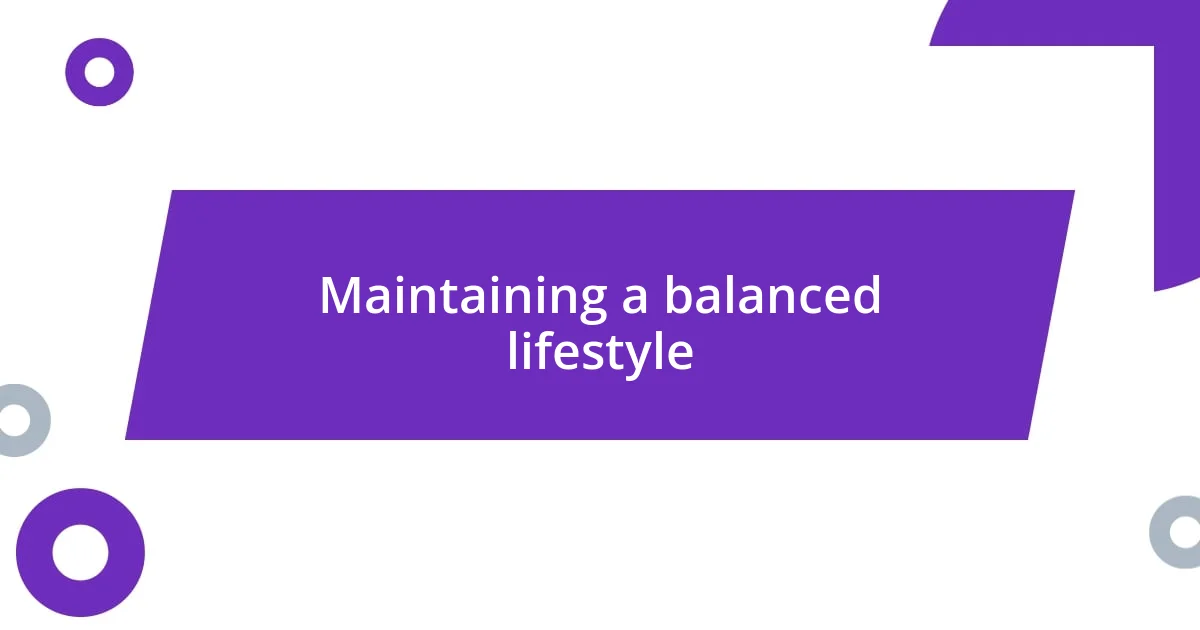
Maintaining a balanced lifestyle
Maintaining a balanced lifestyle is essential for my well-being. I remember a time when I was juggling too many commitments and felt like I was spinning in circles without any direction. I decided to carve out specific blocks of time in my week dedicated solely to hobbies I love, such as painting and gardening. These simple pleasures have become a sanctuary for my mind, providing me with a delightful escape. Have you ever found that special hobby that transports you to a different world?
Another key element is establishing boundaries, especially when it comes to work-life balance. I make it a point to disconnect from emails and work-related tasks after a certain hour. It’s remarkable how saying “no” to work at home allows me to say “yes” to family dinners or a movie night with friends. I feel revitalized after these moments of connection—doesn’t it feel rejuvenating to truly be present with loved ones?
Lastly, I’ve integrated nutritious meals into my daily routine, which surprisingly affects my energy levels. Preparing a colorful salad or trying out a new healthy recipe inspires me to take better care of myself. There’s a certain joy in cooking with fresh ingredients, and I find that mindfulness spills over into other aspects of my life as well. Have you noticed how the food you eat influences how you feel throughout your day? For me, it’s about nurturing both body and soul.












